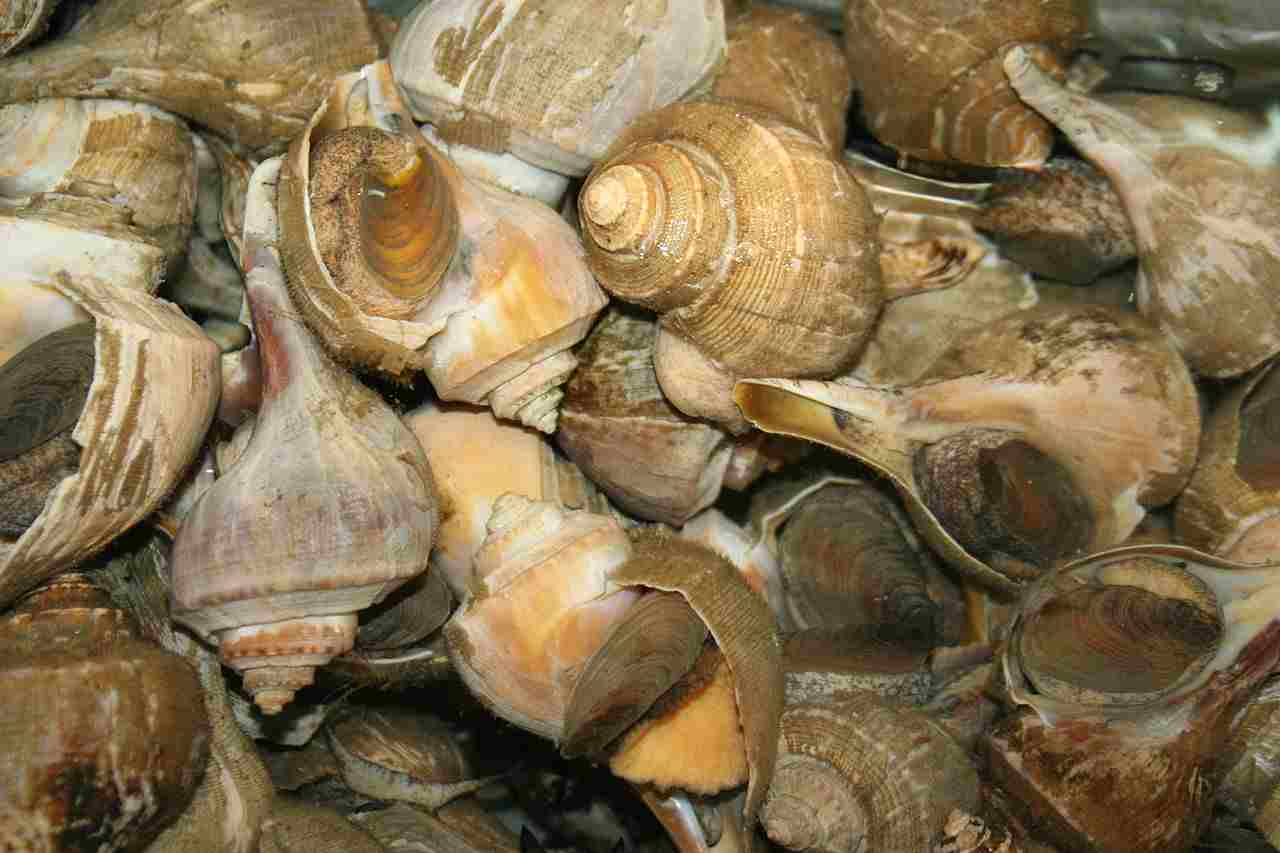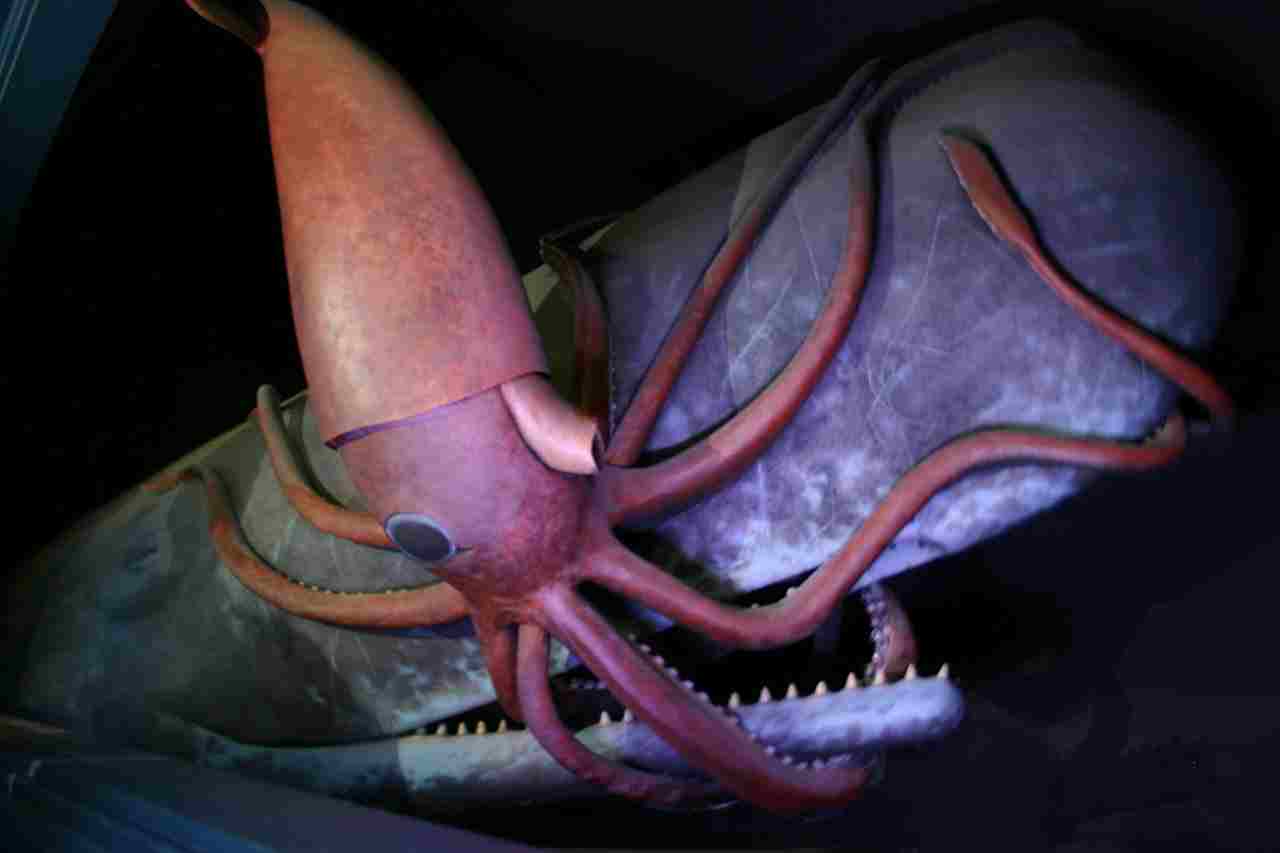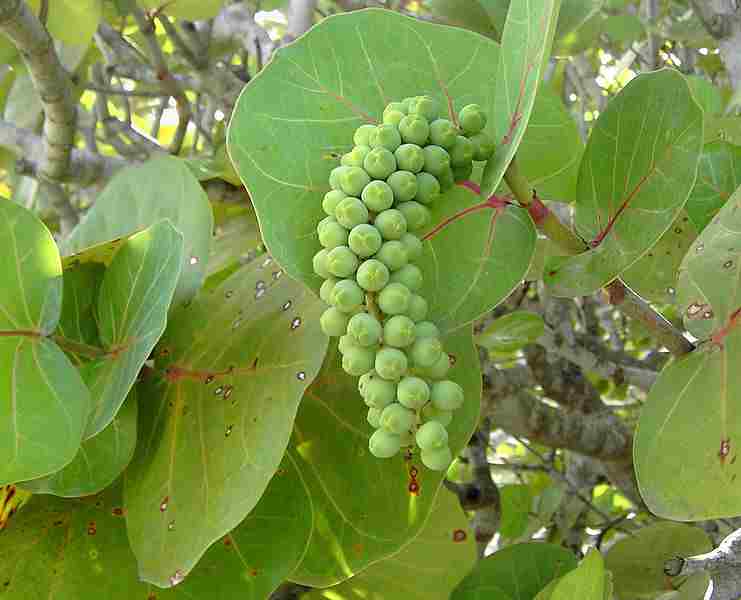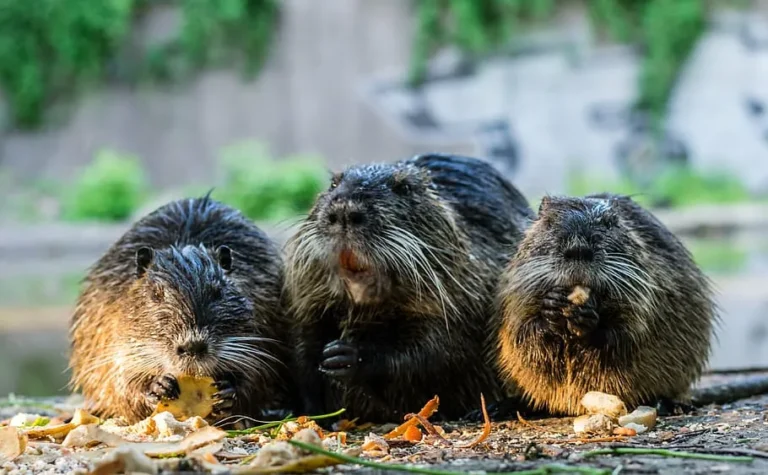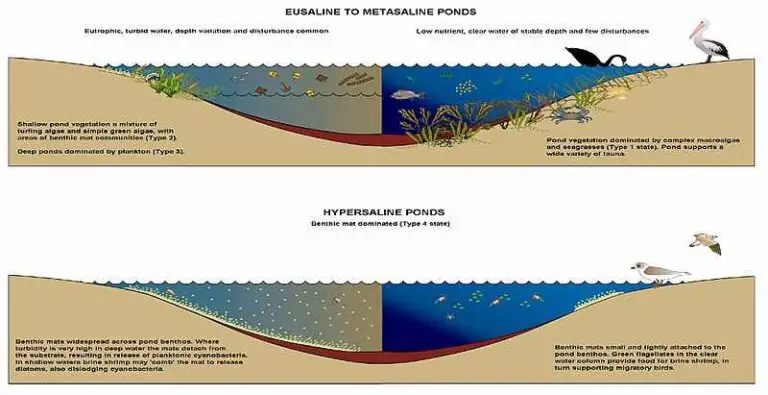What is a Limpet? Analyzing Limpets Within a Biological Context
Limpets are marine mollusks belonging to the class Gastropoda. They are characterized by their shallow, conical shells and broad, muscular foot. Limpets are commonly found clinging to rocks in intertidal zones and other areas. The shape of their shells is often described as patelliform, which means they have a dish-like appearance.
Limpets have a unique adaptation that allows them to tightly attach themselves to rocks, preventing them from being dislodged by waves or predators. This adaptation is their broad foot, which provides them with a strong grip. Limpets also have tentacles that they use to sense their surroundings and locate food. Overall, the physical characteristics of limpets make them well-suited for their rocky intertidal habitat.
Limpet Scientific Name
The scientific name for the common limpet is Patella vulgata. This name is used to specifically identify this particular species of limpet. However, it is important to note that there are other species of limpets that also have their own scientific names. These names are used to classify and differentiate between the various species of limpets.
Limpets, including the common limpet, belong to the order Patellogastropoda. This order encompasses a wide range of limpet species, each with its own unique characteristics and adaptations. By assigning scientific names to these different species, scientists are able to categorize and study them more effectively.
The use of scientific names is crucial in the field of biology as it allows for clear and precise communication among researchers and scientists. These names provide a standardized way of referring to specific species, ensuring that there is no confusion or ambiguity when discussing different organisms.
In addition to the common limpet, there are numerous other species of limpets that have been identified and classified. Each of these species has its own scientific name, which helps to distinguish it from other species within the same order. Some examples of other limpet species include Patella pellucida, Patella ulyssiponensis, and Patella depressa.
By using scientific names, researchers can accurately identify and study different species of limpets, gaining a deeper understanding of their biology, behavior, and ecological roles. These names also allow for the organization and categorization of species, facilitating research and conservation efforts.
What Does a Limpet Look Like?
A limpet is a small marine creature that can be easily recognized by its distinctive appearance. The shell of a limpet is like a small, dish-shaped conical piece of rock. It is conical in shape, with a shallow curve that encloses a small muscular body and a relatively broad foot. The apex of the shell is usually located at or close to the center.
The shell of a limpet is an important characteristic that helps to protect the creature from predators and harsh environmental conditions. It provides a sturdy and protective covering for the limpet’s soft body. The conical shape of the shell allows the limpet to tightly attach itself to rocks or other hard surfaces, providing stability and security.
The overall size of a limpet can vary depending on the species, but they are generally small in size. The shell is typically a few centimeters in diameter, with the body of the limpet fitting snugly inside. The broad foot of the limpet is used for locomotion, allowing it to move slowly and securely across surfaces.
In terms of coloration, limpets can vary from species to species. Some limpets have shells that are a uniform color, while others may have patterns or markings. The coloration of the shell can also be influenced by the environment in which the limpet lives, helping it to blend in with its surroundings.
Overall, the appearance of a limpet is characterized by its small, dish-shaped conical shell, its small muscular body, and its relatively broad foot. These features allow the limpet to adapt and survive in its marine habitat, providing protection and stability.
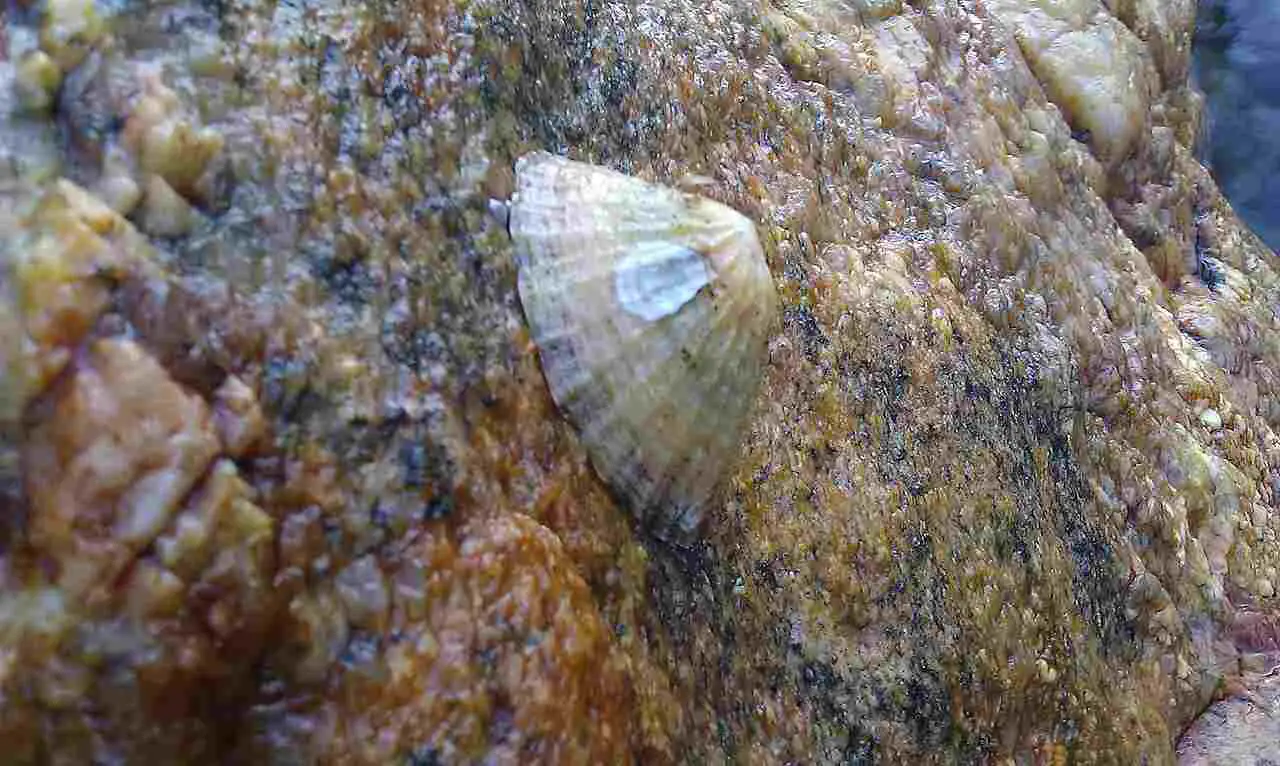
Aspects of Limpets’ Appearance
1). Dish-Shaped Conical Shell
Limpets are known for their distinctive dish-shaped conical shells, which are a key physical feature of their appearance. These shells are typically smooth and rounded, providing protection and camouflage for the limpet. The shape of the shell allows the limpet to tightly adhere to rocks and other surfaces, preventing it from being dislodged by waves or predators.
The dish-shaped conical shell of a limpet is usually made of calcium carbonate, which gives it strength and durability. This shell is formed by the limpet’s mantle, a specialized tissue that secretes the shell material. As the limpet grows, it adds layers to its shell, gradually increasing its size.
The color and pattern of the shell can vary among different species of limpets, ranging from solid colors like brown or gray to intricate patterns and markings. This variation in shell appearance helps limpets blend in with their surroundings, making them less visible to potential predators.
In addition to their shells, limpets have other physical features that contribute to their appearance, such as their small muscular bodies, broad feet, and tentacles. These features play important roles in the limpet’s ability to move, feed, and interact with its environment.
2). Small Muscular Body
Limpets have a small muscular body, which is another important physical feature that contributes to their appearance. The small size of their body allows them to fit snugly within their conical shells, providing protection and minimizing their exposure to potential threats. This compact body shape also helps limpets conserve energy and maintain stability on rocky surfaces.
The muscular body of a limpet enables it to move and cling tightly to rocks, even in the face of strong waves and currents. Limpets use their strong foot muscles to create suction against the substrate, allowing them to resist dislodgment. This adaptation is crucial for their survival, as it helps them withstand the constant pounding of waves and prevents them from being swept away.
The small muscular body of a limpet also plays a role in their feeding behavior. Limpets use their radula, a specialized feeding organ, to scrape algae and other microscopic organisms off rocks. The muscles in their body allow them to exert the necessary force to remove food from the substrate and consume it.
Generally, the small muscular body of limpets is a key physical feature that enables them to thrive in their rocky intertidal habitats. It provides them with the strength, stability, and mobility necessary to survive in challenging environments and fulfill their ecological roles as grazers and algae consumers.
3). Broad Foot
Limpets have a unique physical feature known as a broad foot, which is an important aspect of their appearance. The broad foot of a limpet plays a crucial role in their ability to cling tightly to rocks and withstand the forces of waves and currents. This specialized adaptation allows them to maintain their position and avoid being dislodged from their rocky habitats.
The broad foot of a limpet is equipped with strong muscles that enable them to create suction against the substrate. This suction helps them anchor themselves firmly to the rocks, providing stability and preventing them from being swept away by the movement of the water. The broad surface area of their foot allows for a greater contact area with the substrate, enhancing their grip and increasing their resistance to dislodgment.
In addition to its role in anchoring, the broad foot of a limpet also aids in their feeding behavior. Limpets use their foot to move along the rocks, searching for algae and other microscopic organisms to feed on. The broad surface area of their foot allows them to efficiently navigate the rocky surfaces and maximize their foraging opportunities.
4). Tentacles
Tentacles are another intriguing physical feature that contributes to the appearance of limpets. These appendages play a vital role in the survival and feeding behavior of these marine creatures.
Limpets possess tentacles that are located near their mouth, which is situated on the underside of their conical shell. These tentacles are equipped with sensory cells that allow them to detect and locate food sources in their rocky habitats. By extending and retracting their tentacles, limpets can explore their surroundings and locate algae and other microscopic organisms that serve as their primary food source.
The tentacles of limpets are also involved in their feeding process. Once a food source is detected, the tentacles are used to grasp and manipulate the food, bringing it closer to the mouth for ingestion. This feeding behavior is facilitated by the presence of tiny, hair-like structures called cilia on the surface of the tentacles. These cilia create a current that helps transport the food particles towards the mouth.
In addition to their role in feeding, the tentacles of limpets also serve as a sensory organ. They can detect changes in water movement and vibrations, alerting the limpet to potential threats or disturbances in their environment. This sensory ability allows them to respond quickly and take appropriate action to protect themselves.
Where Do Limpets Live?
Limpets are fascinating creatures that can be found in a variety of habitats, but they are most commonly associated with rocky shores in the intertidal zone. These marine snails have a unique ability to attach themselves to rocks along the coast, allowing them to withstand the constant pounding of waves.
Limpets are specifically adapted to live in the intertidal zone, which is the area between the high and low tide marks. During low tide, when the water recedes, limpets are exposed to the air and must endure harsh conditions such as temperature fluctuations and desiccation. However, during high tide, they are submerged in water, providing them with the necessary moisture and protection.
The rocky intertidal zone is an ideal habitat for limpets because it offers them a stable substrate to attach to and a constant supply of food. Limpets primarily feed on algae, and the rocky surfaces provide ample opportunities for them to access these food sources. The algae grow on the rocks, and limpets use their tentacles to scrape and graze on the algae, sustaining themselves in this harsh environment.
Types of Limpets
The types of limpets are; true limpets, slit and keyhole limpets, small neritic limpets, umbrella slugs, air-breathing limpets, hydrothermal vent limpets, hoof snails, slipped snails, and freshwater limpets.
Of these groups, only the first, which includes members of the clade Patellogastropoda, are considered true limpets. The other groups include mollusks with significant physical and biological similarity to true limpets.
Each type is discussed briefly.
1). True Limpets
True limpets, belonging to the clade Patellogastropoda, are a type of limpets found exclusively in marine environments. They are classified under five living families and two fossil families, with Patellidae being a prominent example. True limpets are characterized by their conical shells and small muscular bodies.
The shells of true limpets are dish-shaped and conical, providing protection and camouflage. These shells are typically smooth and have a rounded apex. The small muscular bodies of true limpets allow them to cling tightly to rocks and other surfaces, even in the face of strong waves and currents.
One distinguishing feature of true limpets is their broad foot, which they use for locomotion and attachment. This foot allows them to move slowly across surfaces and firmly adhere to rocks, preventing them from being dislodged by the force of the water.
True limpets also possess tentacles, which they use for sensory perception and feeding. These tentacles are equipped with chemoreceptors that help them detect food particles in the water. They use their radula, a specialized feeding organ, to scrape algae and other organic matter off rocks.
2). Slit and Keyhole Limpets
Slit and Keyhole Limpets, belonging to the clade Vetigastropoda, are another type of limpets found in marine environments. They include families such as Fissurellidae, which are commonly known as keyhole limpets, and Lepetelloidea, which are small deepwater limpets.
Slit and Keyhole Limpets share some similarities with true limpets, such as their conical shells and small size. However, they also have distinct characteristics that set them apart.
One distinguishing feature of slit and keyhole limpets is the presence of a slit or keyhole-shaped opening in their shells. This opening serves as an exit for waste and reproductive materials. It also allows water to flow over the gills, facilitating respiration.
Slit and Keyhole Limpets are adapted to live in various marine habitats, including rocky shores, intertidal zones, and deeper waters. They have a strong attachment to the substrate, thanks to their muscular foot, which allows them to withstand the force of waves and currents.
These limpets play an important role in marine ecosystems by grazing on algae and other organic matter, contributing to nutrient cycling. They are also a food source for various predators, including birds and fish.
3). Small Neritic Limpets
Small Neritic Limpets, belonging to the clade Neritimorpha, are a type of limpets that are closely related to nerites. These small limpets are found in neritic zones, which are the shallow areas of the ocean that extend from the low tide mark to the edge of the continental shelf.
One distinguishing feature of small neritic limpets is their small size, which allows them to inhabit rocky intertidal zones and other shallow marine habitats. They have a conical shell that provides protection and helps them withstand the force of waves and currents.
Small neritic limpets play an important role in marine ecosystems by grazing on algae and other organic matter. They contribute to nutrient cycling and help maintain the balance of the ecosystem. Additionally, they serve as a food source for various predators, including birds, fish, and other marine organisms.
These limpets have adapted to their environment by developing a strong attachment to the substrate. They use their muscular foot to cling onto rocks and other surfaces, allowing them to withstand the constant movement of the water.
4). Umbrella Slugs (False Limpets)
Umbrella slugs, also known as false limpets, belong to the clade Heterobranchia and the group Opisthobranchia. One example of umbrella slugs is the Tylodinidae family. These slugs have a unique limpet-shaped shell, which sets them apart from other types of limpets.
Similar to true limpets, umbrella slugs are a type of gastropod mollusk. However, they have evolved distinct characteristics that differentiate them from true limpets.
Umbrella slugs are known for their vibrant colors and intricate patterns, making them visually striking creatures. They have a soft body and lack the muscular foot that true limpets possess. Instead, they use a combination of muscular contractions and cilia to move and navigate their environment.
Unlike true limpets, umbrella slugs are not herbivorous grazers. Instead, they are carnivorous predators that feed on small invertebrates and detritus. Their diet consists of various organisms such as small crustaceans, worms, and other mollusks.
Umbrella slugs are typically found in marine habitats, particularly in tropical and subtropical regions. They inhabit rocky intertidal zones, coral reefs, and seagrass beds. These slugs play a crucial role in maintaining the balance of their ecosystems by controlling the population of their prey and contributing to nutrient cycling.
5). Air-Breathing Limpets
Air-breathing limpets belong to the clade Heterobranchia and the group Pulmonata. Examples of air-breathing limpets include the Siphonariidae, Latiidae, and Trimusculidae families. These limpets have evolved the ability to breathe air, which sets them apart from other types of limpets.
Air-breathing limpets have a unique adaptation that allows them to survive in intertidal zones where they are exposed to air during low tide. They possess a specialized respiratory structure called a pallial cavity, which acts as a lung. This cavity is lined with blood vessels that extract oxygen from the air and distribute it throughout the limpet’s body.
Unlike other limpets, air-breathing limpets do not rely solely on seawater for respiration. Instead, they can venture out of the water and breathe atmospheric oxygen. This adaptation enables them to inhabit rocky shores and intertidal areas where they can withstand periods of exposure to air.
Air-breathing limpets play an important role in their ecosystems by contributing to nutrient cycling. They feed on algae and detritus, helping to control the population of these organisms and recycling nutrients back into the environment.
These limpets are typically found in coastal areas, particularly in rocky intertidal zones. They are well-adapted to withstand the harsh conditions of these habitats, including exposure to air, wave action, and fluctuations in temperature and salinity.
6). Hydrothermal Vent Limpets
Hydrothermal vent limpets, belonging to the clades Neomphaloidea and Lepetodriloidea, are a fascinating type of limpet that inhabit deep-sea hydrothermal vents. These vents are found on the ocean floor and release hot, mineral-rich fluids into the surrounding water. Hydrothermal vent limpets have evolved unique adaptations to survive in these extreme environments.
One key adaptation of hydrothermal vent limpets is their ability to withstand high temperatures and pressure. The water around hydrothermal vents can reach temperatures of up to 400 degrees Celsius, and the pressure can be several hundred times greater than at the surface. These limpets have a specialized protein in their shells that helps protect them from the corrosive effects of the vent fluids.
Another remarkable adaptation of hydrothermal vent limpets is their ability to obtain nutrients from chemosynthetic bacteria. These bacteria use the chemicals in the vent fluids to produce energy through a process called chemosynthesis. The limpets have a symbiotic relationship with these bacteria, which live in their gills. The bacteria provide the limpets with nutrients, while the limpets provide a habitat for the bacteria.
Hydrothermal vent limpets are typically found in clusters around the vents, clinging to the rocks and chimney structures. They have a conical shell shape, which helps them anchor themselves in the turbulent water currents near the vents. These limpets play a crucial role in the ecosystem by providing a substrate for other organisms to settle on and by recycling nutrients back into the deep-sea environment.
7). Hoof Snails
Hoof snails, specifically the Hipponix and other Hipponicidae species, are a unique type of limpets that exhibit fascinating characteristics. These snails, which belong to the family Hipponicidae, are known for their hoof-shaped shells and distinct appearance.
One key feature of hoof snails is their shell structure. The shells of these snails resemble a hoof, hence their name. The shape of the shell provides them with stability and protection against predators. Additionally, the shells often have intricate patterns and colors, making them visually appealing.
Hoof snails are typically found in intertidal zones and shallow coastal waters, where they attach themselves to rocks and other hard surfaces. They use their broad foot to firmly grip onto these substrates, allowing them to withstand the force of waves and currents. This adaptation enables them to remain in place and avoid being dislodged.
These snails play an important role in the marine ecosystem. They graze on algae and other microorganisms, helping to control their populations and maintain a balanced ecosystem. Additionally, their shells provide a habitat for other organisms, such as barnacles and small crustaceans, which settle on their surfaces.
8). Slipper Snails
Slipper snails, also known as Crepidula species or slipper limpets, are a fascinating type of limpet found in various marine environments. These snails are characterized by their unique shape, resembling a slipper or shoe. Slipper snails are known for their interesting reproductive behavior and their role in the marine ecosystem.
One key feature of slipper snails is their ability to stack on top of each other, forming a tower-like structure. This behavior, known as “epitoky,” occurs during their reproductive phase. The snails undergo a transformation where the male snails attach themselves to the female snails, forming a stack. This stacking behavior allows slipper snails to release their eggs and sperm into the water column, increasing the chances of successful fertilization.
Slipper snails are commonly found in intertidal zones and shallow coastal waters, where they attach themselves to hard surfaces such as rocks, shells, and even other slipper snails. They use their broad foot to firmly grip onto these substrates, providing stability and protection against waves and currents.
In terms of their ecological role, slipper snails play a vital part in the marine ecosystem. They are filter feeders, consuming plankton and other small particles suspended in the water. By doing so, they help maintain water quality and regulate the population of these microscopic organisms.
9). Freshwater Limpets
Freshwater limpets, specifically the pulmonate river and lake limpets belonging to the Ancylidae family, are a fascinating type of limpet found in freshwater environments. These limpets share similarities with their marine counterparts but have adapted to survive in freshwater habitats.
Like other limpets, freshwater limpets have a conical shell that provides protection and acts as a home. Their shells are typically smaller compared to marine limpets, reflecting the difference in their environment. The small size allows them to navigate through the flowing water and attach themselves to rocks, stones, and vegetation.
Freshwater limpets play an important role in freshwater ecosystems. They are herbivores, grazing on algae and other organic matter that grows on rocks and submerged surfaces. By consuming these organisms, they help to control their population and maintain a balanced ecosystem.
These limpets have a unique reproductive strategy. They are hermaphroditic, meaning each individual possesses both male and female reproductive organs. During mating, they exchange sperm with other individuals, ensuring cross-fertilization. After fertilization, the female limpet lays eggs, which develop into juvenile limpets.
Limpet Teeth Strength
Limpet teeth possess an impressive tensile strength of approximately five gigapascals (GPa), making them one of the strongest known biological materials on Earth. This strength is attributed to the presence of goethite, a mineral found in their teeth. In fact, the tensile strength of limpet teeth is several times higher than the average tensile strength of the strongest spider silk.
The incredible strength of limpet teeth plays a crucial role in their feeding behavior. Limpets use their teeth to scrape and graze on algae and other organic matter that grows on rocks and submerged surfaces. The strong teeth allow them to effectively remove the food source from the substrate, ensuring their survival in their respective habitats.
Despite the remarkable strength of limpet teeth, the practicality of this strength is not entirely known. Researchers are still exploring the specific mechanisms and adaptations that contribute to the teeth’s strength. Understanding the structure and composition of limpet teeth could have potential applications in the development of new materials with enhanced strength and durability.
Types of Limpet Shells
Types of limpet shells are; large common limpet shell, modified flattened shell, discolored shell, and false limpet shell.
They are differentiated mainly by their morphological or structural features.
1). Large Common Limpet Shell
The large common limpet shell, is a type of limpet shell that is found in common limpets. Although it is referred to as “large,” it is actually relatively large compared to other species. This type of shell is characterized by its morphological features and structural composition.
The large common limpet shell is an important aspect of the limpet’s appearance, providing protection and support for the small muscular body of the organism. It has a dish-shaped conical structure that allows the limpet to attach firmly to rocks and other substrates in its habitat. The shell is typically smooth and has a rounded apex, providing a streamlined shape that helps the limpet withstand the strong forces of waves and currents.
In terms of coloration, the large common limpet shell can vary, ranging from shades of brown to gray or even black. This variation in coloration helps the limpet blend in with its surroundings, providing camouflage and protection against potential predators.
2). Modified Flattened Limpet Shell
The modified, flattened limpet shell is a unique type of limpet shell that has formed through evolutionary diversification. This shell is found in species such as black-footed limpets and other smaller species. Unlike the large common limpet shell, the modified flattened limpet shell has a more shallow interior. This adaptation allows the limpet to have a flatter profile, which may provide advantages in terms of locomotion and attachment to substrates.
The modified flattened limpet shell is a type of limpet shell that showcases the diversity within the limpet species. It is interesting to observe how different species have evolved distinct shell structures to suit their specific needs and environments. This variation in shell morphology is a testament to the adaptability and resilience of limpets as a group.
In terms of appearance, the modified flattened limpet shell may have a similar coloration to the large common limpet shell, ranging from shades of brown to gray or black. However, its flatter shape sets it apart from other types of limpet shells. This unique shell structure allows the limpet to navigate its habitat efficiently and securely.
3). Discolored Limpet Shell
The discolored limpet shell is a fascinating type of limpet shell that stands out due to its lack of uniform grey color, which is commonly seen in most limpet shells. Instead, the discolored limpet shell may have lighter colored areas, adding a unique touch to its appearance. One example of a discolored limpet shell is the China Limpet, which showcases a variation in coloration.
This type of limpet shell is an interesting adaptation that allows the limpet to blend in with its surroundings or potentially serve as a form of camouflage. The discolored areas on the shell may help the limpet to avoid predation or enhance its ability to attach to different substrates.
The discolored limpet shell is just one of the many variations found within the diverse world of limpets. Each type of shell showcases the adaptability and resilience of these creatures. By studying the different shell structures and colors, scientists can gain insights into the evolutionary processes that have shaped these organisms over time.
4). False Limpet Shell
False limpet shells resemble true limpet shells but are not identical. One example of a false limpet shell is found in umbrella slugs, which have a unique adaptation that allows them to mimic the appearance of true limpets. These false limpet shells serve as a form of protection, deterring potential predators by resembling a less palatable or dangerous species.
Umbrella slugs, also known as false limpets, have a shell-like structure on their back that closely resembles the shape and texture of a true limpet shell. This adaptation helps them blend in with their surroundings and provides a level of camouflage. By mimicking the appearance of true limpets, umbrella slugs can avoid predation and increase their chances of survival.
While false limpet shells may not be as common as true limpet shells, they are an intriguing example of the diverse adaptations found within the limpet species.
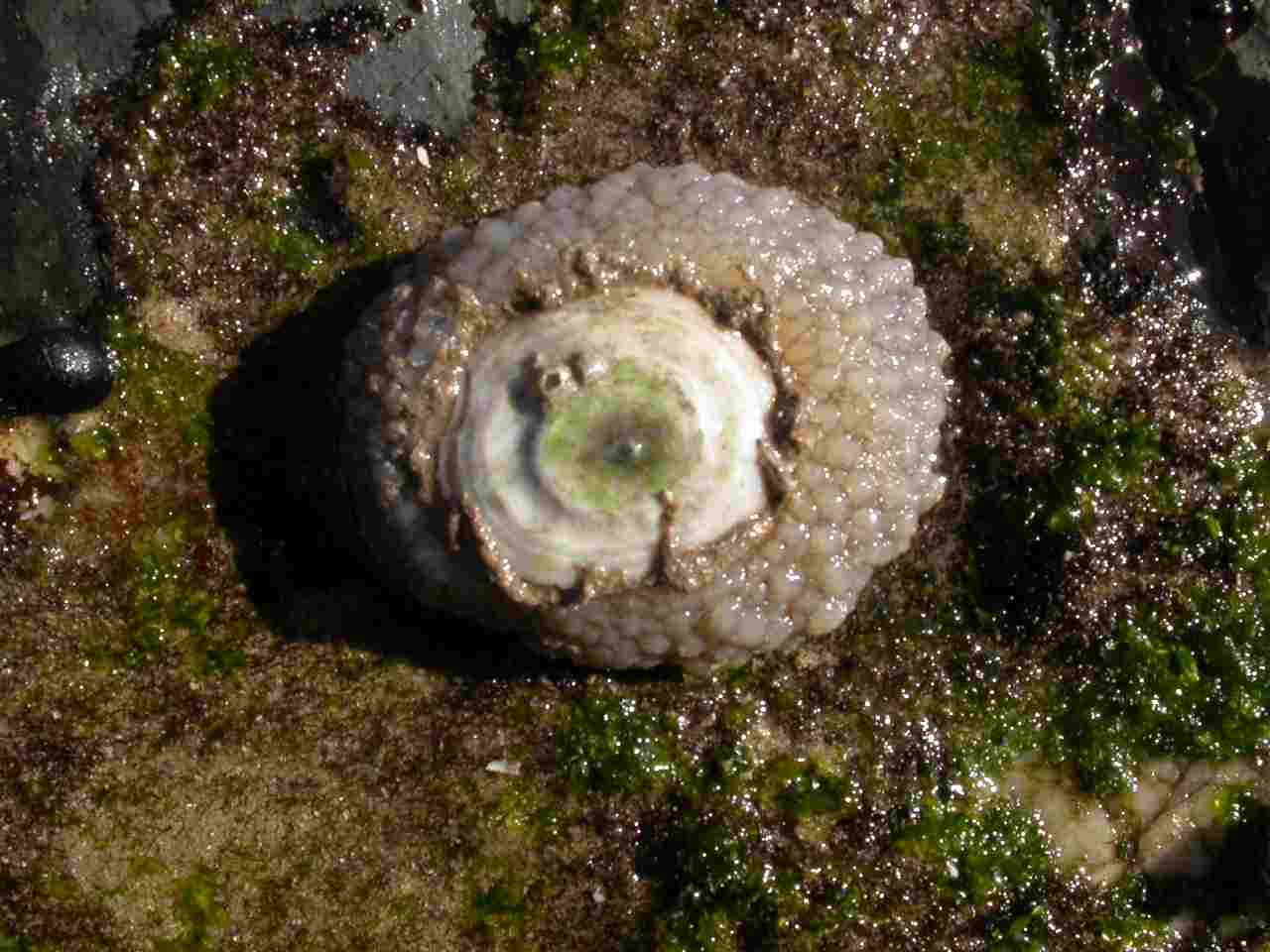
Conclusion
* The different types of limpets discussed in this article include true limpets, slit and keyhole limpets, small neritic limpets, umbrella slugs (false limpets), air-breathing limpets, hydrothermal vent limpets, hoof snails, slipper snails, and freshwater limpets. Each type has its own unique characteristics and adaptations that allow them to thrive in their respective habitats.
* Limpets have a variety of shell types, including large common limpet shells, modified flattened limpet shells, discolored limpet shells, and false limpet shells. These shells provide protection and support for the limpets, and their different shapes and sizes reflect the specific needs and environments of each species.
* Limpet teeth are incredibly strong and are considered one of the strongest biological materials on Earth. Their teeth are adapted to scrape and graze on algae and other food sources, and their strength allows them to withstand the constant wear and tear of their feeding habits.
FAQs
1. What are Limpets Known for?
Limpets are known for their unique ability to cling tightly to rocks along the shoreline. They are small marine gastropod mollusks that have a conical shell and a muscular foot that allows them to attach themselves firmly to the substrate. Limpets are also known for their grazing behavior, as they feed on algae and other microscopic organisms that grow on the rocks.
This grazing activity helps to maintain the balance of the ecosystem by preventing excessive algal growth. Limpets are also known for their strong teeth, which are made of a mineral called goethite. These teeth are incredibly hard and are able to withstand the constant scraping against the rocks as the limpets feed.
The teeth of limpets are currently being studied for their potential applications in engineering and materials science.
2. What is The Meaning of Limpet?
The meaning of a limpet refers to its definition and significance in the natural world. Limpets are small marine gastropod mollusks that are known for their ability to cling tightly to rocks along the shoreline. They have a conical shell and a muscular foot that allows them to attach themselves firmly to the substrate.
Limpets are primarily known for their grazing behavior, as they feed on algae and other microscopic organisms that grow on the rocks. This grazing activity plays a crucial role in maintaining the balance of the ecosystem by preventing excessive algal growth. Additionally, limpets are also known for their strong teeth, which are made of a mineral called goethite. These teeth are incredibly hard and are currently being studied for their potential applications in engineering and materials science.
3. What is a Limpet Good for?
Limpets serve various purposes in the natural world. While they are not commonly consumed as food by humans, they are an important food source for other marine organisms. Their grazing behavior helps to control the growth of algae on rocks, preventing excessive algal blooms and maintaining the balance of the ecosystem.
Additionally, limpets play a role in the nutrient cycling of coastal areas. When they scrape algae off rocks, they release nutrients back into the water, which can be utilized by other organisms.
4. What is a Limpet Made of?
The shell of a limpet is made of calcium carbonate, which provides protection and support for the animal. This hard shell helps to shield the limpet from predators and harsh environmental conditions. The body of a limpet is comprised of soft tissues, including a muscular foot that allows it to cling tightly to rocks.
The foot is equipped with a specialized adhesive gland that secretes a sticky substance, enabling the limpet to adhere firmly to surfaces. This adaptation allows the limpet to withstand strong waves and currents without being dislodged. The combination of a sturdy shell and a strong adhesive foot makes the limpet well-suited for its rocky habitat.
5. What is a Limpet Shell?
A limpet shell serves as a protective covering for the animal. Made of calcium carbonate, it provides a sturdy barrier against predators and harsh environmental conditions.
The shell’s hard exterior shields the limpet’s soft tissues, ensuring its safety and survival. With its unique shape and structure, the limpet shell is designed to withstand the forces of waves and currents, allowing the animal to cling tightly to rocks. This protective adaptation enables the limpet to thrive in its rocky habitat and continue its essential role in the ecosystem.
6. What is a Limpet Fossil?
Limpet fossils are the remains of limpets that lived thousands of years ago. These fossils typically include the shell, which is the most durable part of the limpet’s body. Fossils are often found preserved in sedimentary rocks or in coastal areas where the conditions for fossilization are favorable.
The study of limpet fossils provides valuable insights into the history and evolution of these creatures. By examining the size, shape, and distribution of fossilized limpet shells, scientists can learn about the ancient environments in which they lived and the changes that have occurred over time.
7. What Scientific Class is a Limpet?
Limpets belong to the scientific class Gastropoda. Gastropoda is the largest class of mollusks and includes snails, slugs, and other shell-bearing creatures. This class is characterized by their coiled shells and muscular foot used for locomotion. Limpets, like other gastropods, have a single, coiled shell that provides protection and support.
They are part of the subclass Patellogastropoda, which includes true limpets. Limpets are known for their ability to cling tightly to rocks using their muscular foot, which creates a suction-like effect. This adaptation allows them to withstand the strong forces of waves and tides in their coastal habitats.
8. What is the Family of Limpets?
Limpets belong to the family Patellidae, which includes true limpets. True limpets are characterized by their conical shape and their ability to tightly adhere to rocks using their muscular foot. This family also includes other related families such as Lottiidae and Acmaeidae.
Lottiidae is a family of limpets that are commonly found in intertidal zones and rocky shores. They have a flattened shell and are known for their ability to withstand the strong forces of waves and tides. Acmaeidae, on the other hand, are limpets that are typically found in subtidal habitats. They have a more elongated shell and are adapted to live in deeper waters.
These different families of limpets share similar characteristics, such as their ability to cling to rocks and their coiled shells. However, they may have slight variations in their shell shape and habitat preferences.
9. What does a Limpet Look Like to the Human Eye?
When observing a limpet with the naked eye, it appears as a conical piece of rock clinging tightly to the surface. The shell of a limpet is typically smooth and rounded, with a slightly pointed apex. The color of the shell can vary, ranging from shades of brown to gray or even greenish hues. Some limpets may also have patterns or markings on their shells, adding to their visual appeal.
The size of a limpet can vary depending on the species, but they are generally small in size, typically measuring a few centimeters in length. Their shape and size allow them to fit snugly onto rocks, providing them with protection from predators and the harsh elements of their environment.
In addition to their shell, limpets have a muscular foot that is used for locomotion and attachment. This foot is usually dark brownish in color and can be seen protruding from the underside of the shell when the limpet is active.
10. What Does a Limpet Look Like Inside?
Inside the shell of a limpet, you will find a small, dark brownish muscular body. This body is responsible for the locomotion and attachment of the limpet to rocks. The muscular foot, which is usually dark brownish in color, can be seen protruding from the underside of the shell when the limpet is active.
The internal structure of a limpet is relatively simple. It consists of a digestive system, reproductive organs, and a circulatory system. The digestive system allows the limpet to feed on algae and other microscopic organisms that grow on rocks. The reproductive organs enable the limpet to reproduce and continue its species. The circulatory system ensures the distribution of nutrients and oxygen throughout the body.
While the external appearance of a limpet may be more visually striking, the internal structure is equally fascinating. It is through this intricate internal design that limpets are able to survive and thrive in their rocky habitats.
11. Can Limpets Live Out of Water?
Limpets are marine creatures that are adapted to live in the intertidal zone, which means they are exposed to both air and water. While they are primarily aquatic animals, limpets have the ability to survive short periods of time out of water.
Limpets have a unique adaptation that allows them to withstand the harsh conditions of the intertidal zone. They have a muscular foot that they use to attach themselves firmly to rocks, even during low tide when they are exposed to air. This foot creates a seal between the limpet and the rock, preventing dehydration and protecting them from drying out.
During low tide, when the limpet is exposed to air, it closes its shell tightly to retain moisture and reduce water loss. This adaptation allows them to survive for several hours out of water. However, limpets still rely on being submerged in water to obtain oxygen and nutrients. Therefore, they cannot live permanently out of water.
12. Are Limpets in Freshwater or Saltwater?
Limpets are primarily found in saltwater or marine environments. They are adapted to live in the intertidal zone, which is the area between the high and low tide marks. This means that they are exposed to both air and water during the tidal cycle. While most limpets are found in saltwater, there are some species that can tolerate freshwater environments.
These freshwater limpets are often referred to as false limpets. They have similar physical characteristics to their saltwater counterparts, such as a conical shell and a muscular foot for attachment. However, they have adapted to survive in freshwater habitats, such as rivers, lakes, and ponds.
13. What are Limpets also Known as?
Limpets are also known as marine snails or sea snails. These names reflect their close relationship to snails and their habitat in the marine environment. Limpets share similar characteristics with snails, such as a conical shell and a muscular foot for attachment. However, unlike snails, limpets have a flattened shell and a unique ability to cling tightly to rocks using their strong foot.
This adaptation allows them to withstand the force of crashing waves and remain firmly attached to their chosen substrate. The alternative names for limpets highlight their association with the snail family and their preference for living in the sea.
14. How do Limpets Move?
Limpets move using their muscular foot, which is a key adaptation that allows them to navigate their rocky habitats. The foot of a limpet is strong and flexible, enabling it to grip onto surfaces and move in a slow, gliding motion. When a limpet wants to move, it contracts its foot muscles, creating a suction-like effect that helps it detach from the surface.
It then extends its foot forward and reattaches it to a new spot, repeating this process to gradually inch its way along. This movement is relatively slow, but it is effective for the limpet’s needs. By using their muscular foot, limpets can explore their surroundings, find food, and seek shelter from predators or harsh environmental conditions.
15. How Long Do Limpets Live?
Limpets have varying lifespans, with the exact duration depending on several factors. The average lifespan of a limpet is approximately 10 years, but this can vary depending on the species and environmental conditions. Some limpets may live for as short as a few years, while others can survive for up to 20 years.
The lifespan of a limpet is influenced by factors such as predation, habitat quality, and availability of food. Limpets that face high predation pressure or live in harsh environments may have shorter lifespans. Conversely, those in protected areas with abundant food sources may live longer.
Additionally, the size of a limpet can also affect its lifespan. Larger limpets tend to have longer lifespans compared to smaller ones.
16. How do Limpets Stick to Rocks?
Limpets are able to stick to rocks using their muscular broad foot. This foot is specially adapted to create a strong suction force that allows them to firmly attach to the substrate. The foot secretes a mucus-like substance that helps to create a seal between the foot and the rock surface, enhancing the suction effect.
This adhesive ability enables limpets to withstand the strong waves and currents in their rocky intertidal habitats. The foot can be retracted or extended as needed, allowing limpets to move and reattach themselves to different areas of the rock. This unique adaptation ensures that limpets can securely cling to rocks, even in challenging environments.
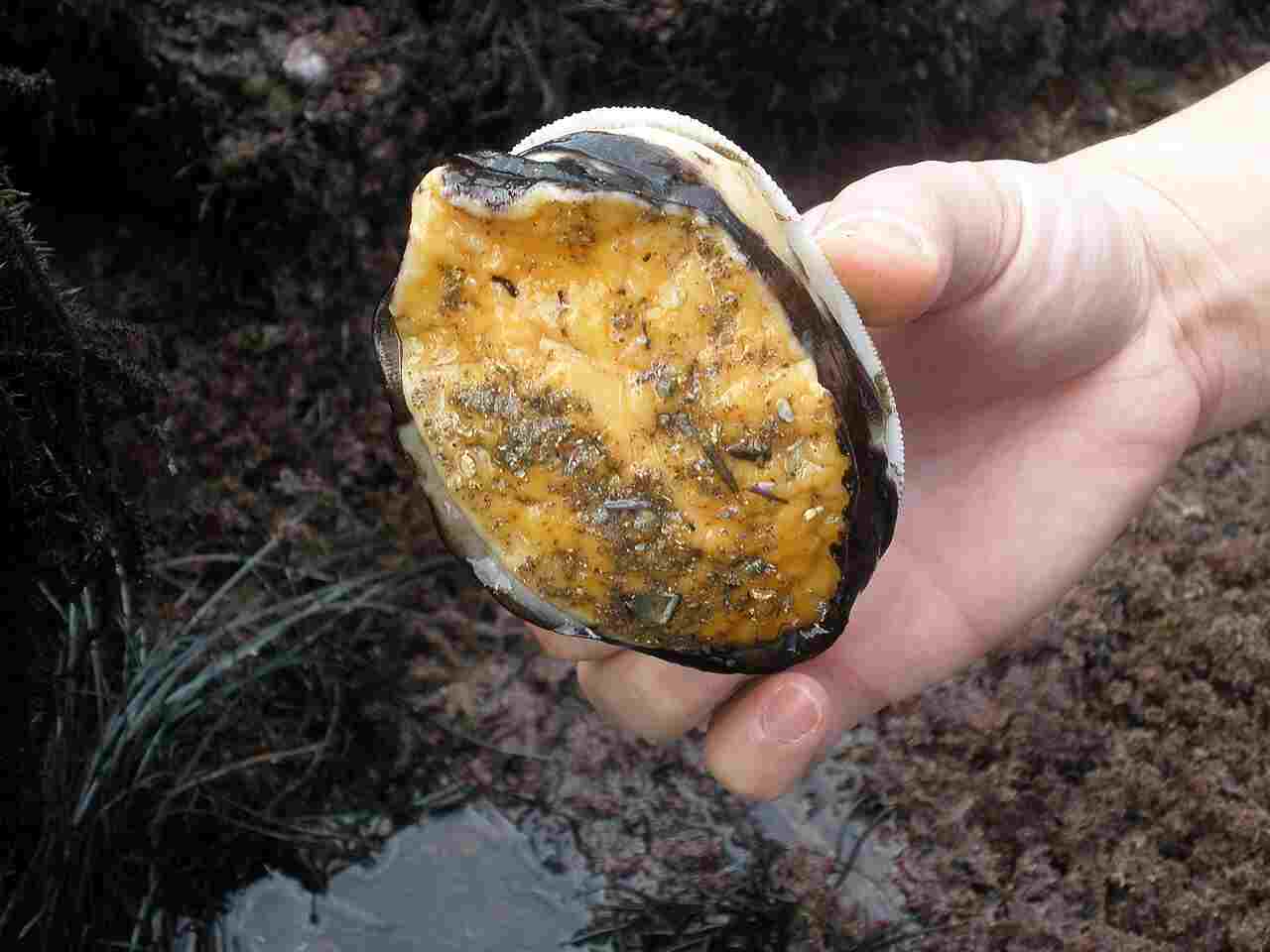
17. How is the Limpet Classified?
Limpets belong to the mollusk family and are classified under the class Gastropoda. The class Gastropoda includes a wide range of snails and slugs, and limpets are a subcategory within this class.
As mollusks, limpets share certain characteristics with other members of their class. They have a soft body protected by a hard shell, which is typically conical or cap-shaped. Limpets also have a muscular foot that they use for locomotion and attachment to rocks.
Within the class Gastropoda, limpets are further classified into different families based on specific characteristics and features. These families include Patellidae, Acmaeidae, and Lottiidae, among others. Each family has its own unique traits and adaptations that distinguish them from one another.
The classification of limpets helps scientists and researchers understand their evolutionary history, relationships with other organisms, and ecological roles. By studying the classification of limpets, scientists can gain insights into their behavior, habitat preferences, and adaptations to different environments.
18. Are Limpets a Type of Snail?
Limpets are indeed a type of snail, belonging to the subcategory of Gastropoda. As mentioned earlier, Gastropoda is the class that encompasses a wide range of snails and slugs, and limpets fall within this classification.
Like other snails, limpets have a soft body protected by a hard shell. Their shells are typically conical or cap-shaped, providing them with the necessary protection. Limpets also possess a muscular foot that they use for both locomotion and attachment to rocks.
While limpets share similarities with other snails, they also have their own unique traits and adaptations that distinguish them. These adaptations allow them to thrive in their specific habitats and fulfill their ecological roles.
19. Where are Limpets Found?
Limpets are found in a variety of habitats, but they are most commonly found in intertidal zones. These zones are the areas along the shoreline that are exposed to air during low tide and covered by water during high tide. Limpets are well-adapted to this dynamic environment, as they are able to withstand exposure to air and extreme temperature fluctuations.
Intertidal zones can be found along coastlines all over the world, from rocky shores to sandy beaches. Limpets attach themselves to rocks or other hard surfaces using their muscular foot, which allows them to stay in place even when waves crash against them. This attachment is crucial for their survival, as it prevents them from being swept away by the strong currents.
In addition to intertidal zones, limpets can also be found in subtidal areas, which are permanently underwater. These areas provide a different set of challenges and opportunities for limpets, as they must compete with other marine organisms for resources and space. Generally, limpets have a wide distribution and can be found in various marine habitats around the world.
20. How Strong are Limpets Teeth?
Limpets have incredibly strong teeth, capable of withstanding immense pressure. The strength of their teeth is measured at an impressive 5 gigapascals. These teeth are composed of a mineral called goethite, which gives them their remarkable durability.
The teeth of limpets are specifically designed to scrape and graze on algae and other microorganisms found on rocks. They use their teeth to rasp away at the surface, creating a smooth feeding area. This constant scraping and grinding require teeth that can withstand the repetitive forces exerted during feeding.
The strength of limpet teeth is comparable to some of the strongest materials found in nature, such as spider silk and human bone. In fact, limpet teeth are even stronger than titanium, a commonly used metal known for its strength and durability.
The incredible strength of limpet teeth is a testament to the adaptability and resilience of these marine creatures. It allows them to thrive in their rocky habitats, where they can securely attach themselves and feed on the abundant algae. The strength of their teeth ensures that they can continue to graze and survive in the challenging intertidal and subtidal zones they call home.
21. What is the Bite Force of a Limpet?
The bite force of a limpet is not distinctively measured due to its microscopic size. However, despite their small stature, limpets possess impressive feeding capabilities. Using their strong teeth, limpets are able to scrape and rasp away at the surface of rocks, consuming algae and other microorganisms. While the exact force of their bite remains unknown, it is evident that their teeth are well-equipped for their feeding habits.
The bite force of limpets is a fascinating aspect of their biology, showcasing their ability to adapt and thrive in their rocky habitats. By continuously grazing on algae, limpets play a crucial role in maintaining the balance of marine ecosystems. Their feeding behavior and the strength of their teeth inspire both dental and engineering developments, highlighting the potential for biomimicry in various fields.
22. Is Limpet Teeth Stronger Than Titanium?
Limpet teeth may be small, but they possess remarkable strength that rivals titanium. This surprising fact has captured the attention of both dental and engineering fields, inspiring new developments in materials and design. The strength of limpet teeth, despite their microscopic size, showcases the incredible adaptability and resilience of these marine creatures.
The comparison between limpet teeth and titanium highlights the potential for biomimicry, where nature’s designs are imitated for practical applications. By studying the structure and composition of limpet teeth, scientists and engineers can gain insights into creating stronger and more durable materials.
The strength of limpet teeth not only contributes to their feeding habits but also demonstrates the incredible capabilities of nature’s creations. This discovery opens up possibilities for advancements in various industries, from dentistry to construction, where strength and durability are essential.
